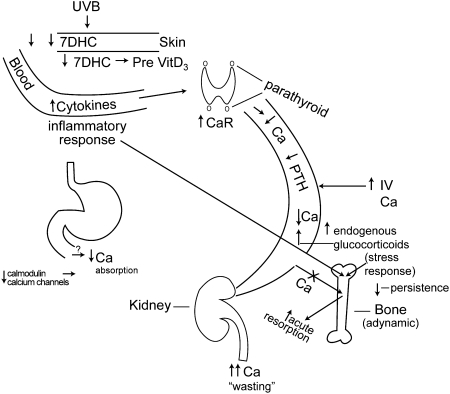Figure 1.
This diagram depicts the mechanisms discussed in postburn bone loss. UVB radiation to the skin acts on a diminished amount of vitamin D precursor, 7DHC and an abnormally reduced percentage of 7DHC is converted to pre-vitamin D3. In addition the level of cytokines in the blood increase secondary to the inflammatory response and these elevated cytokines act on the parathyroid gland to upregulate the membrane-bound CaR. This leads to reduced circulating calcium and reduced PTH secretion and results in renal calcium wasting. Additionally, the inflammatory response acts directly on the bone synergistically with the stress response to cause both proinflammatory cytokines and endogenous glucocorticoids to stimulate osteoblast RANK ligand production to increase acute bone resorption. However, with the persistence of the stress response, the osteoblasts and likely the osteocytes become apoptotic and bone turnover is markedly reduced, leading to adynamic bone and a consequent inability of bone to take up calcium from the blood. Finally, potential zinc deficiency might lead to conformational changes in calmodulin and/or the calcium channels, resulting in reduced gastrointestinal calcium absorption. CaR, calcium-sensing receptor; 7DHC, 7-dehydrocholesterol; PTH, parathyroid hormone.

